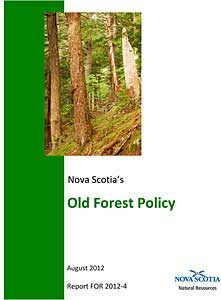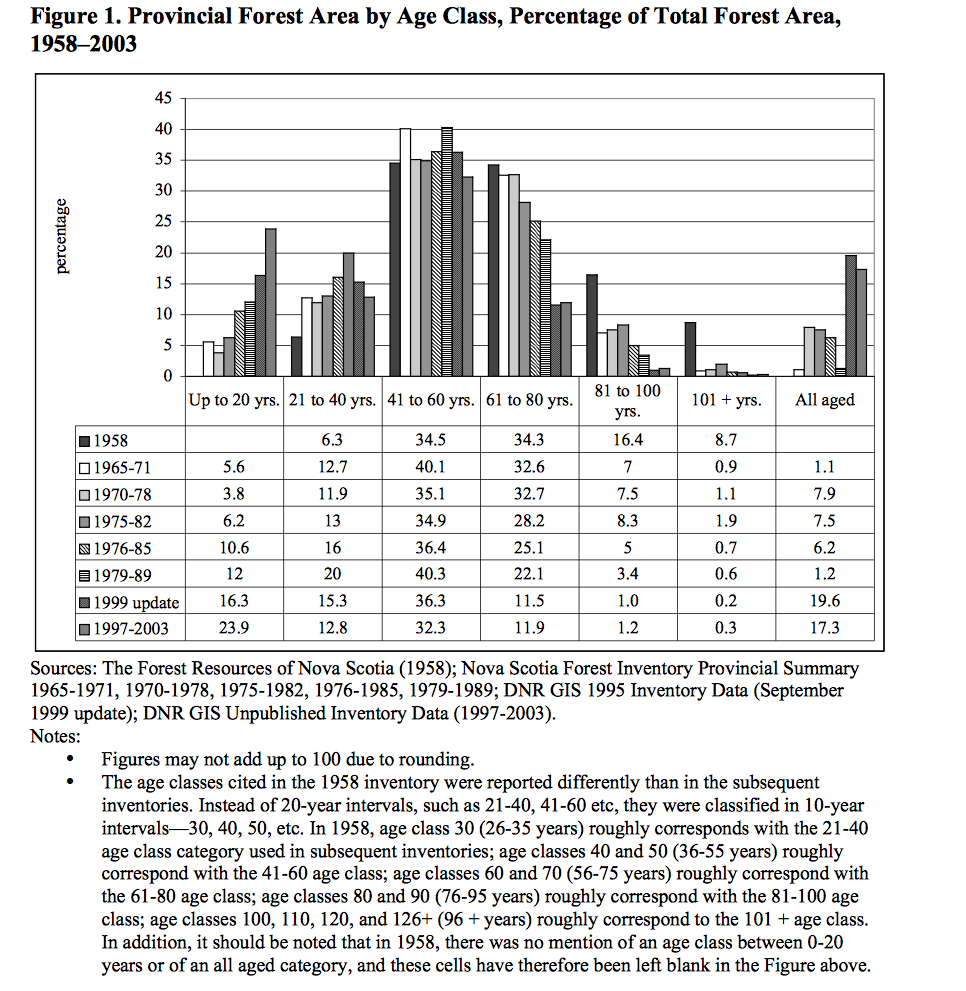 Nova Scotia’s Old Forest Policy
Nova Scotia’s Old Forest Policy
NSDNR, August 2012. “The Old Forest Policy will conserve the remaining old growth forests on public land and ensure that a network of the best old forest restoration opportunities is established. This network will support, and be supported by, broader sustainable forest management initiatives that address maturity and community representation across ecological landscapes.’
Implementation of Nova Scotia Interim Old Forest Policy for Crown Land “A Status Report”
NSDNR Prepared by Bruce Stewart and Peter Neily March 2008. Very relevant maps and stats.
Implementing Ecosystem-based Integrated Resource Management in Nova Scotia
Bruce Stewart and Peter Neily, 2008. pp 71-77 in
Implementing Ecosystem-based Management Approaches in Canada’s Forests. A Science-Policy Dialogue Edited by Brenda McAfee and Christian Malouin Published by Natural Resources Canada Canadian Forest Service Science and Programs Branch Ottawa. from p 75 “The Interim Old Forest Policy, 1999, established an objective to identify and protect the best remaining old forests and old-forest restoration opportunities on a minimum 8% of Crown land in each of the 39 ecodistricts (NSDNR 1999b). Most of this objective has now been met.” References: Nova Scotia Department of Natural Resources. 1999b. Nova Scotia’s old growth forests: interim old forest policy. www.gov.ns.ca/natr/forestry/planresch/oldgrowth/policy.htm [Accessed January 2008.] This is no longer available via the web (12May2022)
Old Growth
Page on NSDNR website, with brief history of the Old Forest Policy and links. “Once a hallmark of the Acadian Forest, old growth has become rare. Under the Interim Old Forest Policy introduced in 1999, over 200,000 ha of forest has been identified on Crown land which conserves a network of old forest restoration opportunities and remnant old growth (>125 years old). Conservation of old forests on private land is actively encouraged and supported through several initiatives, while research is ongoing to develop tools, monitor progress, and better define old growth in different forest communities.”
How much “Old Growth” do we have in NS?
Here is some of what has been available publicly:
– “The 1999-2003 provincial forest inventory (NSDNR, 2004) indicates that only 0.3 percent of the province is over 105 years of age. (Stewart & Neily 2008)
– “Today 91 per cent of Nova Scotia forests are even-aged and are less than 100 years old.”
Module 4: Woodlots and Wildlife, 2011

From Nova Scotia GPI Forest Accounts, 2008 Update
Also see comments by Peter Bush of NSNRR
The age and structural characteristics of tolerant old growth forests in eastern mainland Nova Scotia
M.E. Pollock, 202. Thesis for Bachelor of Environmental Studies at St.Mary’s University, Halifax. ABSTRACT Old growth forests in Nova Scotia found in the Acadian forest ecosystem are becoming a rare in the landscape, one that provides unique ecological services and biodiversity. Understanding the many components such as disturbance regimes, successional stages and species composition found in old growth forests are essential for better forest management strategies for the few old growth forests we have left. Under the definition and restrictions of the Nova Scotia 2012 old forest policy, red maple does not classify as a climax species. In order to better old growth forest management, this study explored red maple’s structural parameters in tolerant hardwoods to compare similarities to other tolerant hardwood climax species, sugar maple and yellow birch. The study concluded that in at least one forest stand; red maple, acts like a climax species and with the absence of sugar maple, the red maple trees are able to recruit into the overstory canopy. It is concluded that more replicates of the study must be completed in order to confidently include red maple as a climax species.
Selected Nova Scotia old-growth forests: Age, ecology, structure, scoring
Bruce Stewart et al.(2003). The Forestry Chronicle 79: 632-644. This paper provided key data for developing the criteria for assessing Old Growth status under Nova Scotia’s Old Forest Policy (above)
MTRI Old Forest Project
Ongoing. View also: Peter Bush, NSDNR – Nova Scotia’s Old Forest Management at MTRI Old Forest Conference in 2016.
Old forest policy and regulatory frameworks in Nova Scotia and New Brunswick with a comparison to British Columbia
Amy Berry, Amanda Lavers and Lisa Mitchell The Forestry Chronicle, 2018, 94(1): 13-19
ABSTRACT: Old growth forests (OGF) represent ecological continuity and are rich in biodiversity. These unique landscapes are becoming increasingly rare in Canada, especially within the Acadian Forest Region that covers the Maritime Provinces. Less than 1% of the total forest cover in these provinces is OGF — this is drastically lower than the 55% represented in British Columbia’s Temperate Coastal Rainforest. The authors of this paper conducted a comprehensive comparative analysis of old forest policies and regulatory frameworks in Nova Scotia, New Brunswick and British Columbia to offer recommendations for improving the conservation and stewardship of OGF in the Maritimes. The analysis revealed that in Nova Scotia there is a strong old forest policy underpinned by a quantitative scoresheet, coordinator, and database. In New Brunswick and Nova Scotia the conservation targets are up to 8% on Crown land, but neither have a regulatory framework nor have evidence of achieving these targets. British Columbia has integrated Forest Stewardship Plans that promote the retention of OGF as legally enforceable tools for licensees in Old Growth Forest Management Areas. Such an approach could prove useful in improving the restoration and conservation of OGF in the Maritime Provinces.
Old Forest Layer in the Nova Scotia Provincial Landscape Viewer
Once in the Viewer, Select the layer at Forestry>Forestry>Old Forest Policy
From the Help Page:
The old forest layer maps the locations of stands that were selected under the Interim Old Forest Policy of 1999 (novascotia.ca/natr/library/forestry/reports/Old-Forest-Policy-2012.pdf). The forests identified in the layer consist of old growth stands, as well as mature stands set aside to restore old growth. According to the policy these stands will be maintained and left to mature naturally with no management intervention. Most of the forests in this layer are not old growth. The majority are mature climax stands that provide good opportunities for long-term old growth restoration. They were selected following the Procedures in the Interim Old Forest Policy. True old growth forests are uncommon, and make up only a small proportion of the stands in this layer. The location of all old growth in the Province is unknown, however DNR maintains a registry of old stands that have been evaluated using DNR’s Old Forest Scoring system (novascotia.ca/natr/forestry/programs/ecosystems/scoresht.asp). The 2008 report “Implementation of Nova Scotia Interim Old Forest Policy for Crown Land – A Status Report” provides a summary of the forest stands contained within the old forest layer. (novascotia.ca/natr/library/forestry/reports/state-of-forest-old-growth.pdf).
Loon Lake area harvests: DNR seeks shelter in its Old Forest Policy
Post, March 4
Rick Howe talks to Bob Bancroft about Nova Scotia DNR cutting Old Growth forest
Post, March 6, 2018
Old Growth among Us: A Characterization of Urban Old-Growth Forests in Halifax
Wendy Margetts, Environmental Science Undergraduate at Dalhousie University. Supervisor: Peter Duinker, SRES Professor at Dalhousie University. April 2015, 44 pp
Abstract: Currently, there is little research in the field of urban old-growth forests. This study aims to address this issue, furthering our knowledge of urban old-growth in Nova Scotia. The research focuses on identifying similar forest characteristics between forests in Halifax urban core and in the hinterland of Nova Scotia. The field work and data analysis demonstrate that urban and hinterland forests have similar live tree and deadwood characteristics, providing a basis to classify these Halifax urban forests as old growth. This research can be further used to promote visitation to these accessible forest locations, and to manage the sites for old-forest characteristics.
